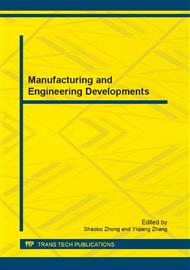p.623
p.631
p.636
p.641
p.646
p.650
p.654
p.660
p.665
Study on the Composition and Control of Robot Structure
Abstract:
Robot is a typical representative of high-tech research results. In a robot, the wisdom of human is applied throughout its whole structure, and also task commands are executed through an intelligent control system. Human society is always progressive and innovative. It is believed that great breakthroughs will be made to the future robots in structural combination, automatic control, working performance and so on. China is still a country in the developing stage, and therefore the research and manufacturing activities of robot products will be increasingly more. It is necessary for the research and development of robots at any period to give priority to "functional standards". On this basis, a study is made in this paper.
Info:
Periodical:
Pages:
646-649
Citation:
Online since:
January 2013
Authors:
Keywords:
Price:
Сopyright:
© 2013 Trans Tech Publications Ltd. All Rights Reserved
Share:
Citation:


